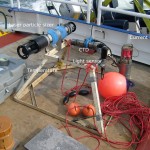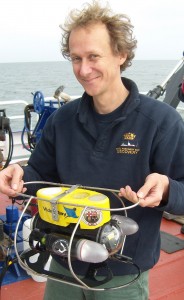With my long standing collaborator Kim Last from SAMS and MSc student Harri Condie, we recently conducted a field trip to Sabellaria spinulosa habitats in the Wash. Sabellaria spinulosa is a polychaete worm that builds dwelling tubes out of suspended particles. As part of a project with Kim, funded by the Aggregate Levy, we are working to better understand these amazing reef-building creatures.
Armed with the best gear we could find at short-notice, we constructed a mini-lander system to be deployed near a S. spinulosa reef. We equipped the system with sensors that included a laser particle sizer set to provide information on the particle supply in the region, a current meter, temperature loggers and a CTD system logging not only temperature, salinity and depth but also light attenuation and dissolved oxygen.
We left the lander on the seafloor for 24 hours, providing a valuable insight into the particles that may be supplied to the S. spinulosa reef. To supplement this, we also placed out sediment traps on the amazing intertidal reef at Scotsman’s Sled. These traps are basically tubes that allow sediment to settle to the bottom, we then take the sediment back to the lab and look at the type and quantity of particles, including any organic food particles that land into the trap. These particles allow us to verify the readings from the particle sizer but also provide a vital clue to why S. spinulosa is found in that area.
We were out with the Eastern Sea Fisheries Joint Comittee on board their boat the Three Counties. They even let us have a go with their amazing little ROV, a VideoRay. Seriously, we’re thinking that we could do with one! Many thanks to ESFJC and the crew for supporting our research.
We’ve only been back a few days, so our data is still being downloaded off our instruments. But these observations will hopefully be the first of many, as we attempt to determine the underlying environmental controls for S. spinulsa. This work was related to the MEPF/ALSF project (MEPF 08/p76), where we are using our novel VoRT tanks to better understand the impact of aggregate dredging on a range of different species.


